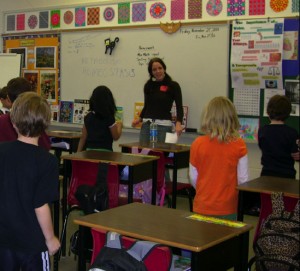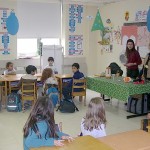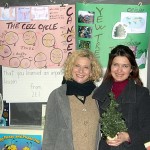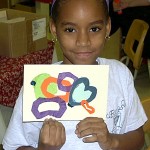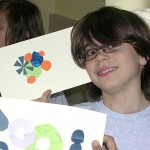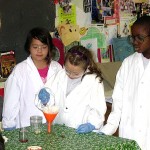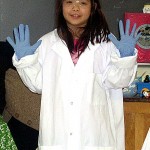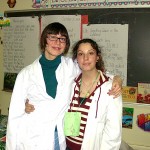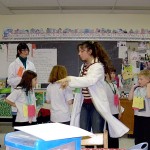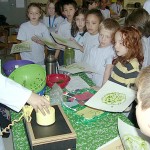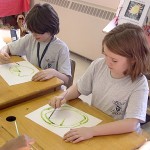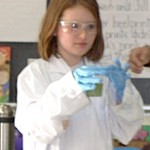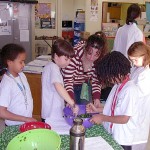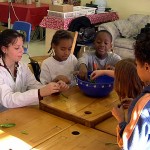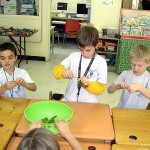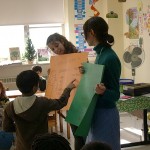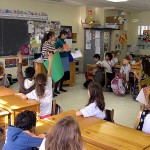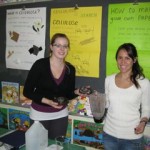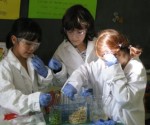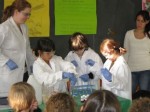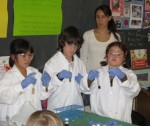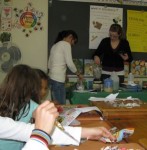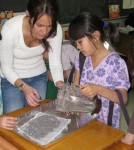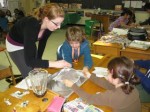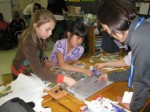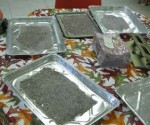Taxol
October 6, 2011 in Plants
On Wednesday, November 19th, 2008, the students in Mrs Shuster’s third grade class at École F.A.C.E. School were extracting natural products from plants and using their powers of perception to identify them, thanks to university students Alexandra Cadar (B.Sc., U. Montréal) and Julia Waks (BA Art Education, Concordia U). Alexandra and Julia engaged the class in a discussion on plant derived products. As an example, slices of aloe-vera were cut and distributed to the students to present an example of a beneficial plant because of its powers to treat burns and wounds. Similarly, vitamin C was mentioned as an essential nutrient for good health, obtainable from lemons and oranges. After refreshing the students memory on proper safety attire, three volunteers performed extractions of three samples of different leaves by pipetting hot water over each and collecting the colored extracts. Using their sense of smell and examining the color, the students were able to identify the leaf samples from cranberry, camomile and mint. A discussion of the medicinal attributes of these plants followed.
Alexandra and Julia introduced next the molecule of the day “Taxol” which is extracted from the bark of the Yew tree. Yew trees, are evergreens that can look like Christmas trees. They are slow growing, some are estimated to be as old as 4,000 years. Yew trees are difficult to start from seed, because they germinate only after passing through the gut of some animal, such as an elk or deer. Native American Indians used the wood from the Yew tree to make archery bows and paddles, Europeans used it to make musical instruments. About 40 years ago, scientists studied and tested the different parts of the Yew tree and discovered that the bark of the tree and some other parts of the tree contained an active molecule, that they named “Taxol”. Taxol is now used as a medicine to fight cancer. The students related their own stories about their interactions with family and friends with cancer, which led to a deeper discussion about this disease and the application of taxol as a cure. Finally, considering the many rings in the structure of taxol, the students made collages featuring rings on the front-side of get-well cards to be delivered to children with cancer at the Montreal Children’s Hospital.
The 3rd graders and all thanked team taxol for their thought provoking and sensitive presentation of the wonders and benefits of plant natural products.
Alexandra Cadar (B.Sc., U. Montréal) and Julia Waks (BA Art Education, Concordia U) leading a discussion on plant-derived products.TACJWclass[1].jpg ¬
Note last week, as mentioned in our MLP on Taxol, the students made collages featuring rings on the front-side of get-well cards, that were delivered to children with cancer at the Montreal Children’s Hospital. As Julia Waks from Team Taxol writes:
“Attached are the photos taken at the Montreal Children’s hospital. The “absolutely adorable get well cards” were very well received by the staff at both the haematology out patient clinic as well as the 8th floor oncology ward. Mrs.Terry Seguin, head of communications at the hospital, (in photo)and other staff members were very enthusiastic and helpful. The cards look great and will be much appreciated by the kids, parents and staff. Bravo to all the kids for a job well done.”


